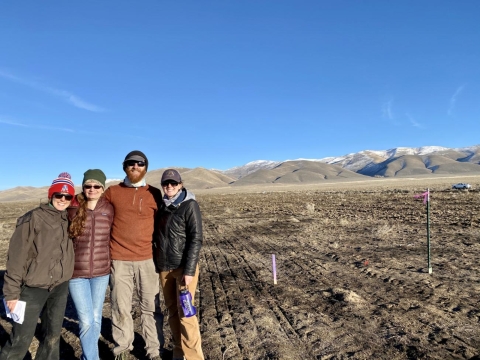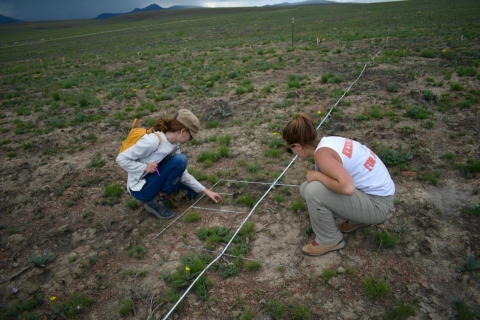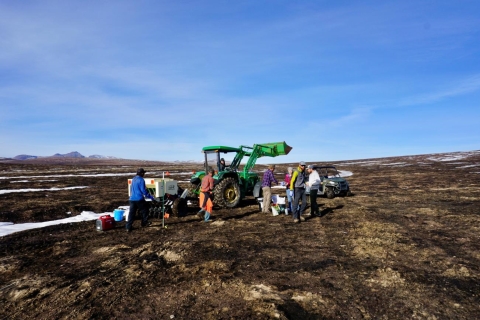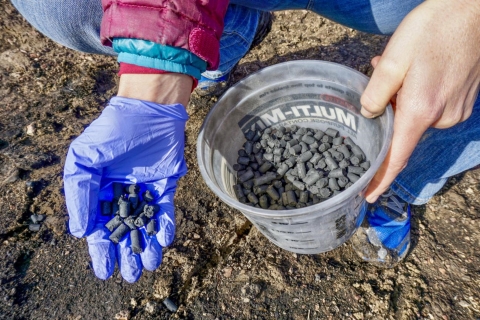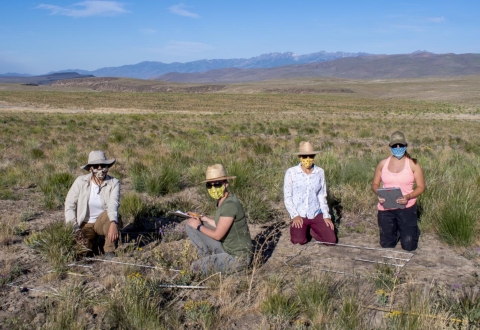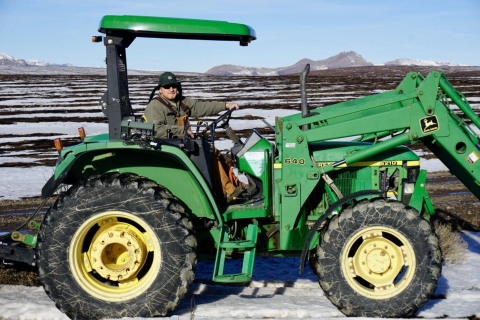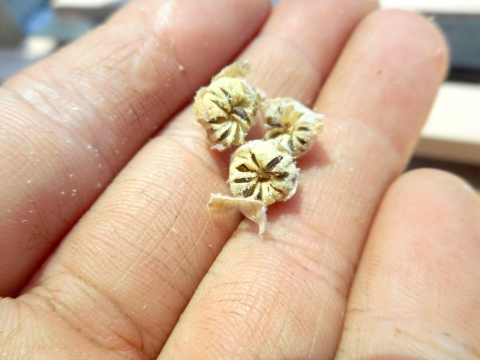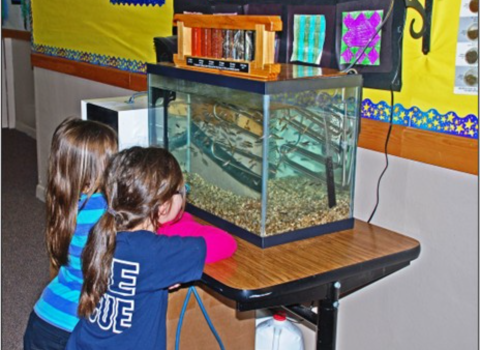The idea of using local, native seeds in restoration is taking off, just like the wildfires they are designed to follow, as ecologists and botanists in Nevada embark on research to test the use of these seeds in helping burned areas recover and become resilient.
“Nevada is fascinating. It is at the center of the Great Basin and the center of native seed discussions right now,” said Beth Leger, Professor of Biology, at the University of Nevada, Reno.
Leger has been on faculty at UNR since 2006 and says the best thing about her job is seeing her graduate students make a difference in the plant world. “My former students are spread out across the West. Since they know each other, they’re able to form easy partnerships, which allows us to pull off the impossible,” said Leger.
In 2018, Leger began working with her very first graduate students - Sarah Kulpa, now a restoration ecologist and botanist for the U.S. Fish and Wildlife Service in Reno, Nevada, and Owen Baughman, a precision restoration scientist with The Nature Conservancy in Burns, Oregon - on a new and ambitious project.
Sarah Kulpa, left, U.S. Fish and Wildlife Service, Beth Leger, left center, University of Nevada, Reno, Owen Baughman, right center, The Nature Conservancy, and Alison Agneray, University of Nevada, Reno, seeding rows at the 2019 Rebel Creek Fire in December 2019. Photo courtesy of Sophia Heston/Great Basin Institute
“We wanted to see how local, native seed would compare to conventional seeding mixes in post-wildfire rehabilitation. Everything just came together because we have such wonderful partners with the Winnemucca Bureau of Land Management who were willing to help us make our crazy idea a reality. We had both the increased, local native seed available through the Seeds of Success program and an opportunity to seed after the 2018 Martin fire and two additional fires in 2019. This kind of experiment hasn’t been done in Nevada’s sagebrush sagebrush
The western United States’ sagebrush country encompasses over 175 million acres of public and private lands. The sagebrush landscape provides many benefits to our rural economies and communities, and it serves as crucial habitat for a diversity of wildlife, including the iconic greater sage-grouse and over 350 other species.
Learn more about sagebrush landscape before, so it’s exciting,” Kulpa said.
Beth Leger, left, Professor at University of Nevada, Reno, and Sophia Heston, Great Basin Institute ecologist, collect year one data on the Martin Fire in June 2019. Credit: Sarah Kulpa/USFWS.
In 2018, the Martin Fire rolled through central Nevada, quickly becoming the largest fire in state history. It burned more than 435,000 acres or 680 square miles of sagebrush habitat, an area larger than the City of Los Angeles.
Historically, sagebrush wildfires occurred every 30 to 100 years. Today, they are happening every five to 15 years, in part due to the spread of invasive plant species like cheatgrass. Cheatgrass emerges early in the spring, outcompeting native plants, and then dries up quickly, creating fields of wildfire fuel in the Intermountain West.
“If a fire rolls through sagebrush country, it can create a vicious cycle of invasion by cheatgrass, followed by more fire unless we step in to help break the cycle through use of integrated treatments that include the restoration and seeding of native plants,” says Lindy Garner, the Service’s invasive species invasive species
An invasive species is any plant or animal that has spread or been introduced into a new area where they are, or could, cause harm to the environment, economy, or human, animal, or plant health. Their unwelcome presence can destroy ecosystems and cost millions of dollars.
Learn more about invasive species coordinator for the sagebrush ecosystem. “The system needs help to tip the balance back in favor of the native plant community.”
The Martin Fire near Winnemucca, Nevada in June 2018. This fire quickly became the largest in state history. Photo courtesy of Sebastian Christianson/Sawtooth Interagency Hotshot Crew.
Without intentional efforts by land managers to restore land after a wildfire with the right seeds, invasive plants often take advantage of open landscapes and move in, exacerbating the cycle of wildfire.
“Restoration is complex. Especially in a harsh landscape like Nevada. You can do everything right, but if you miss one component, the whole restoration project can fail. We’re fine-tuning the process and trying to figure out how much the level of seed localness matters,” Baughman said of the project.
Ecologists and land managers are comparing three restoration seed mixes: 1) conventional mixes, which are a combination of non-native and native species that are sourced from out of state; 2) local, native seed mixes of species collected on the Winnemucca BLM district in Nevada; and 3) ”herbicide protection pods” filled with local, native seed.
“This effort is unique because we’re utilizing seed from the local area, which increases their chances of success to thrive and outcompete the invasive, annual grasses, and decreases the fire-fuel cycle we have seen over the past few years,” said Andrew Laca, natural resource specialist for the Winnemucca BLM.
The Bureau of Land Management Winnemucca District and The Nature Conservancy prepping the tractor and drill for seeding after the 2018 Martin Fire. Credit: Sarah Kulpa/USFWS
In comparing seed mixes, the partners hope to answer crucial questions: Is the combined use of carbon pods and herbicide effective in controlling invasive plants and establishing native seedlings? Do local, native seeds work as well or better than the conventional seed mixes? Do local, native seed mixes compete with cheatgrass as well as conventional seed mixes? What seed mix best supports long-term site diversity?
“Packaging the seeds with activated carbon in herbicide protection pods helps protect native seeds from herbicides that control invasive species. This technology has been used in agriculture for years, and TNC and its partners are adapting it for use in restoration projects,” said Baughman.
Herbicide protection pods or carbon pods full of native seeds at the Martin Fire site. Credit: Sarah Kulpa/USFWS.
Since the technology is also more expensive than normal seed, TNC is testing it at large and realistic scales to see if it is a viable option in restoration.
While studies comparing the use of native seed mixes verses conventional mixes (non-native and native species) are limited, it has long been established that locally sourced seed matters. But how much does the level of localness matter in a restoration site?
Typically, in Nevada, conventional rehabilitation seed mixes are composed of non-native species and/or native seed that is sourced from out of state. The native plants often do not perform well because the seeds are adapted to different growing conditions, which are often wetter and cooler than Nevada.
“Traditionally, seeds are collected from somewhere that gets 20-25 inches of precipitation a year, planted in an area of Nevada that receives eight to ten inches of rain a year, and then they don’t grow. That’s because they’re not adapted to the climate of Nevada,” said Leger. “But plants grow here, Nevada is covered in plants. So in this project we are collecting seeds in dry areas and using those seeds for restoration projects in dry areas.”
Cathy Silliman, left, (University of Nevada, Reno), Alison Agneray, left center, (University of Nevada, Reno), Sarah Kulpa, right center, (U.S. Fish and Wildlife Service) and Sophia Heston (Great Basin Institute) collecting year two data on the 2018 Martin Fire seeding study. Credit: Jason Forgette/USFWS volunteer.
In past studies, Leger’s lab has compared non-local and local native species in small gardens, but not on a large scale.
“In the small gardens, the locally sourced native seeds do better, and we’re trying to figure out if we’ll get the same result on a restoration scale. That’s why this is such an important project,” said Leger.
The Martin Fire test plots were seeded in December 2018. With more wildfires in 2019, the same group had additional opportunities to test their questions about seed mix performance again on the Winnemucca BLM district at the Rebel Creek and Sheep Canyon fires, which they seeded in December 2019.
“We will have initial results from the seeding in three to five years and hope to get longer-term results as well. These plots are small, but the goal is to turn this into something bigger. We ultimately would love to test these different seed mixes on larger restoration sites to see what happens,” Kulpa added.
Rob Burton, now retired from Winnemucca Bureau of Land Management, drives the tractor and drill seeder on the 2018 Martin fire. This was Burton’s last project before retirement. Burton’s leadership is responsible for the Seeds of Success collections and native seed increases that made experimental plantings at these three fires possible. Credit: Sarah Kulpa/USFWS.
Seeds collected by Seeds of Success interns in Nevada. Credit: USFWS

